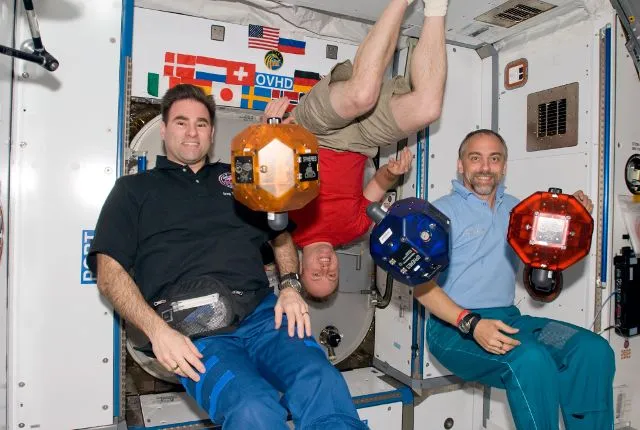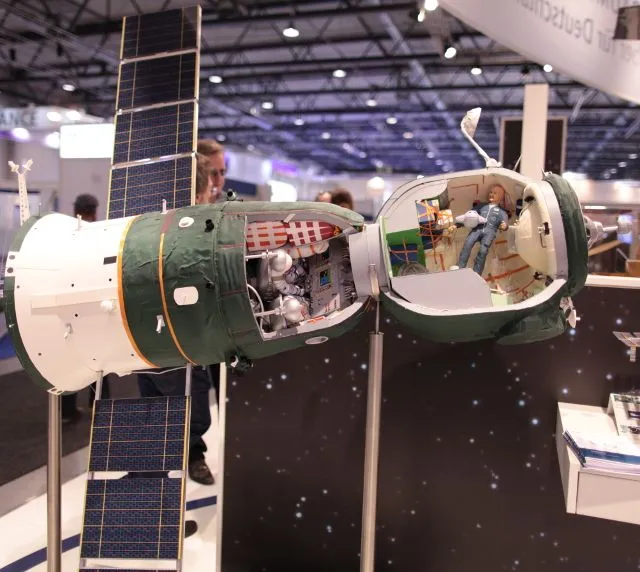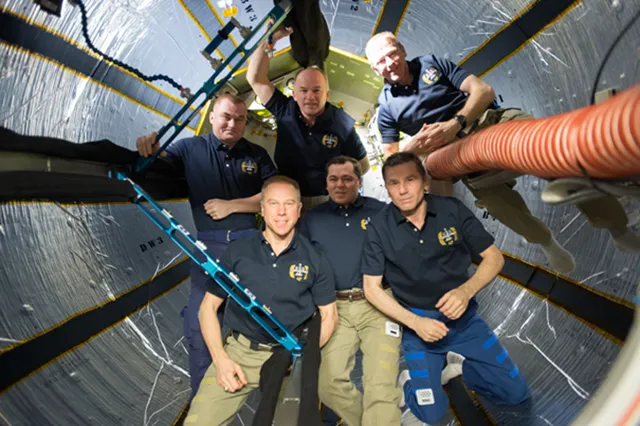Whoever remembers the buzz about space tourism in the first decade of the 21st century may be surprised by the subtitle. How come nobody loves orbital tourists? Everyone loved them! From Roscosmos (Russian space agency), whom they brought much needed money for Soyuz flights, to Space Adventures, who organized (and charged for) these trips to the International Space Station, to a wide audience of fans who followed with admiration (and jealousy) what seemed to be a new era of private space flight.

The sixth space tourist Richard Garriott (right) in the American part of the International Space Station (source: NASA via Wikimedia Commons)
However, if all was going so well and the future was so bright, why did we move orbital tourism to past tense? Of course, the lucky seven had tasted Russian hospitality in orbit (one of them even twice!) but the last of those flights took place in 2009 and sadly there are few signs that this state of affairs would change quickly. Let's check it taking a closer look at the contemporary and potential players of the orbital tourism market.
Before we verify it let me emphasize fundamental differences between orbital tourism, and those short jumps above the conventional boundary of space (100 km altitude) called suborbital flights. The latter offer several, at most a dozen or so minutes of weightlessness and a view of the black void over the rounded Earth, but ...
- Suborbital tourism has never even started. Although there was even more buzz about it than around Soyuz flights to the station, made by people extremely experienced in making noise like Richard Branson (Virgin Galactic), not even one flight with passengers on board happened so far.
- Suborbital hops last so short that seats are all the equipment needed by passengers. Orbital flights, much more difficult to carry out by the laws of physics, must offer a much longer stay in space to compensate for the many times higher prices. This means that in addition to usually cramped vehicle, you need a more spacious accommodation too.

Soyuz is really small. Neither the lander (center part) nor the orbital module (on the right) are the place for a week-long vacation for three. Other spacecrafts offer similar comforts (source: DLR via Wikimedia Commons)
So where do you look for transport and accommodation in hope for orbital tourism to return and thrive?
Roscosmos
The only entity that owns both is Roscosmos (the Russian space agency). They showed they are not afraid of letting an amateur aboard Soyuz or the Russian part of ISS (International Space Station). Mainly because most of related problems were left for the tourist (and NASA) to clear up, about which you could write a whole separate article. However, since Roscosmos was taking tourists to the ISS so smoothly, why did the adventure end? Well, it didn't! The Russians were transporting paid passengers before 2001 (before the first tourist), they were flying them in the meantime and they still do. As long as the sums add up, it did not matter if such a passenger has the official blessing of his country's space agency or a private corporation. Even better, the former are usually better prepared physically and professionally for flights, making fewer problems and bringing less complains from NASA about their visits in American part of the ISS.
Paid Soyuz passengers in 2006-2008
| Soyuz TMA-8 | Marcos Pontes | (Brazil, AEB agency) |
|---|---|---|
| Soyuz TMA-9 | Anousheh Ansari | (USA, tourist) |
| Soyuz TMA-10 | Charles Simonyi | (USA, tourist) |
| Soyuz TMA-11 | Sheikh Muszaphar Shukor | (Malaysia, ANGKASA agency) |
| Soyuz TMA-12 | Soyeon Yi | (South Korea, KARI agency) |
| Soyuz TMA-13 | Richard Garriott | (USA, tourist) |
Since the permanent ISS crew was enlarged to 6 people (2009), Roscosmos has, however, full occupancy of seats in Soyuz, taken by astronauts from the USA, Japan, Canada and the European Space Agency. And despite rumors of Sarah Brightman's unsuccessful approach to a space trip (already estimated at $ 51.8 million), we can safely bet that nothing changes until new US spacecrafts enter service (around 2020). These accommodate up to 7 crew members and equally increase the limit of ISS expedition size. Theoretically, there will be no reason for Soyuz flights then, but they surely will be maintained if for prestigious reasons - it is difficult to build a narration about powerful Russia without its own spacecraft. Prestige, however, is not something you can pay your bills in, so we may see free seats in Soyuz again. However, for orbital tourists to take them a combination of following circumstances is needed: deterioration of the country's economy, ISS partners' preference for new US vehicles and lack of volunteers sponsored by other countries (like Brazil / Malaysia / South Korea in 2006-2008) Also let's keep in mind that private tourists bring no prestige to state agency, on the contrary – it is a sign of poverty, which is why I am convinced we'll not see them aboard Soyuz again.
SpaceX & Boeing
Let's be optimistic that both SpaceX's Crew Dragon and Boeing's CST-100 Starliner perform successful manned flights this December. Both companies will start providing manned transport services for NASA, which has no motivation to share the spaceships or ISS room with some rich people. So if SpaceX or Boeing want to handle them, they need to build their own space station, or rather find someone who will do it for them, because none of these companies have plans to build space stations. SpaceX's goal is Mars, and Boeing's goals are best summarized by the quote "We just want to be the trucking company". Fortunately, there is someone who wants to build orbital space stations and only waits for private taxis to fly there:
Robert Bigelow
The billionaire who has already sent three foldable modules into space, the latest one serving the ISS residents as a warehouse. The man who funded an (unclaimed) $ 50 million prize for a private orbital flight, waiting to launch private space stations once a private transport gets available.

The interior of Bigelow Expandable Activity Module, unfolded after attaching to the ISS. The full-scale modules of its station are to be many times larger. (source: NASA via Wikimedia Commons)
This is the space tourist's dream come true, you could think, if not for a small detail – when you browse the websites of Bigelow's companies you won't find any mention of space tourism or tourists. Even the word hotel is used only by editors of various news websites, probably because the Bigelow's fortune originates from the network of budget (earth) hotels. It seems that the dream users of Bigelow's habitats are
- NASA
- Space agencies of countries too small or too poor to afford their own space program, such as the aforementioned Brazil, Malaysia and South Korea
- Corporations willing to carry out research in microgravity.
Even if Space Adventures (which mediated in sending the lucky seven to the ISS) would like to expand its profile and rent a module plus Dragon or Starliner transport, you certainly can't find a trace of enthusiasm for space tourism at Bigelow's.
As you can see those who could realistically taxi and host orbital tourists are not really into it. If they do, it is rather because of the lack of other preferred clients. The only entity really interested in development of this sector is Space Adventures - the last hope for potential private astronauts. Maybe the attitude will change when manned suborbital jumps, promised for more than a decade by Virgin Galactic (SpaceShipOne) and Blue Origin (New Shepard) finally take off. Maybe.
PS I deliberately omitted in the above considerations the proposal of a tourist flight around the Moon with a Dragon vehicle, put forward by the owner of SpaceX. I did it because no more than a month ago Elon Musk suggested that he would stop producing Falcon rockets and Dragon vehicles to concentrate on a completely new rocket that would replace all current ones. So I decided to wait until Musk decides on one of his ideas.
Sources: press releases of the companies and agencies mentioned, also my external memory banks Encyclopedia Astronautica http://astronautix.com and manned spaceflight website (in Polish) http://lk.astronautilus.pl